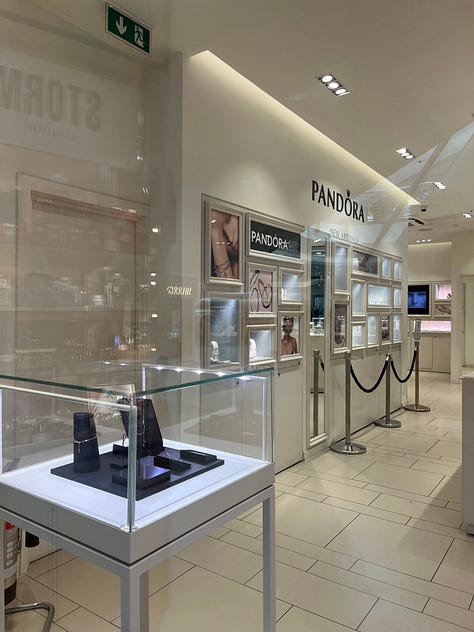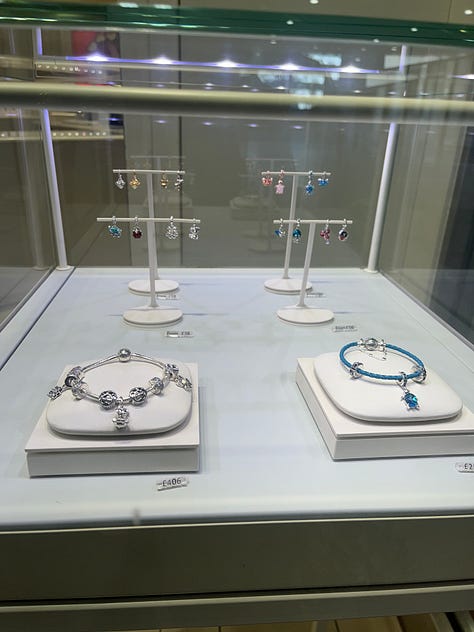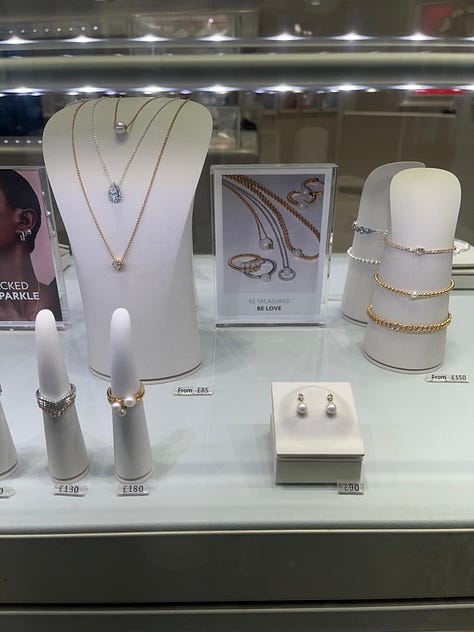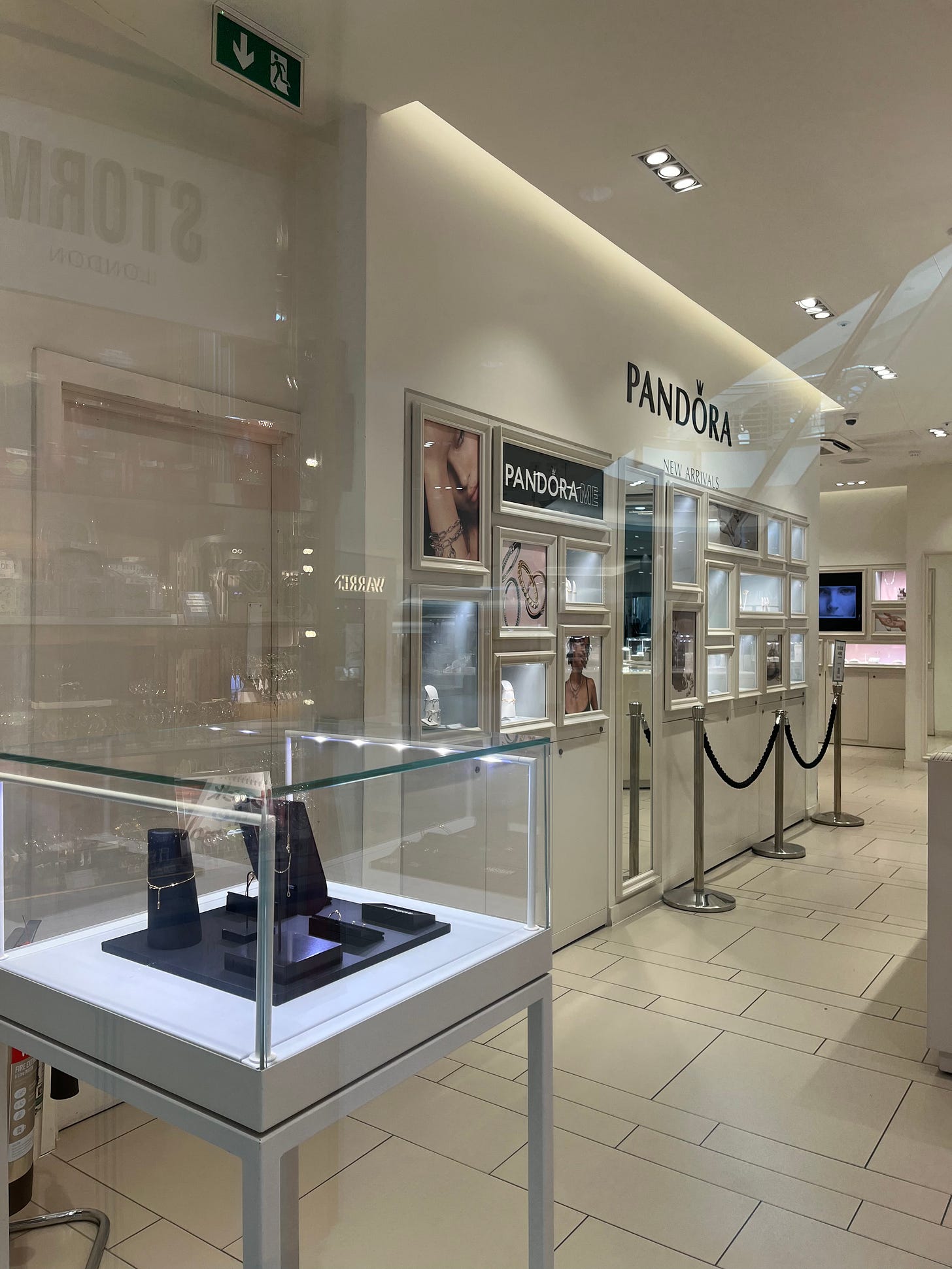Retail Lab: Let’s Discuss Pandora’s Success Strategy
Jewellery is big business across the fashion and retail landscape, and in this week’s Retail Lab, I dive in to how and why Pandora is going from strength to strength.
For some clothing brands like J Crew, jewellery is a smaller category, but one that enhances their main collection and drives wider market trends (case in point: the bubble necklace).
For others, jewellery can define a core offer and take centre stage, like Kate Spade where classic products are blended in a range with fun, trendy and colourful pieces that provide an entry-level price point (and a talking point).
Then there’s the luxury jewellery brands like Tiffany and Co and Cartier where jewellery is an investment purchase made to mark the most special of moments, and bought to keep forever and pass on.
What we’ve seen in the past decade is a rise in the number of jewellery brands who sit somewhere in between, providing a luxury product and experience, promising longevity and quality, without the price tag, and this is where Pandora sits, and thrives.
Let’s dive in to their success story.
But first, context.
Pandora is the world’s largest jewellery brand.
In November, against a tough economic backdrop, the company reported its fifth consecutive quarter of double-digit organic growth, a remarkable feat made even more so when compared to its high end rival LVMH whose jewellery and watches division “reported a 5% decline in the first nine months of the year”.
You can read more about these impressive numbers here in the company’s FY 2024 highlights report.
Known for its charm bracelets, Pandora has signalled its intention to become a full jewellery brand and the destination for all jewellery buying needs. Underpinning this drive is the Phoenix Strategy, comprised of four pillars that support growth and expansion: brand, design, personalisation and core markets.
This robust strategy is paying dividends, so let’s take a look at it in action.
What is driving customers to Pandora?
More often than not, when I pass by a Pandora there’s a queue of customers waiting for a sales assistant, and often, that stretches to outside the store. It’s a popular place to shop, and here’s why:
Design is central to everything they do. Pandora’s pieces are unique and the range strikes the perfect balance between classic items and trend-led pieces. They use silver, gold, rose gold, pearls, lab-grown diamonds and other gemstones so there is something for everyone.
Collaborations and limited edition ranges are a big draw. The enduringly popular Pandora x Disney collection pieces might seem niche, but they’re high quality and appeal to enthusiasts across different demographics, with character designs mixed in with more subtle nods to the Disney franchise.
Their brand ambassadors are carefully chosen to appeal to a wider demographic. For example, the Be Love initiative has featured Pamela Anderson and the new campaign stars Winona Rider and Iman, all of who appeal to an older customer the brand wants to win over. This campaign is also a clever way to move Pandora away from the charm bracelet brand it was once known for, and towards a more grown-up full jewellery brand that still sells the best charm bracelets.
Sustainability is a big draw and last year’s announcement that the brand would now only use recycled metals and invest in this change without passing on costs to customers has landed well with those concerned about mining and CO2 emissions.
The Pandora store experience is personal, and knowledgable sales assistants make suitable recommendations so the customer leaves with what they need. It sounds simple, but this one-to-one jewellery shopping experience was once exclusive to high-end jewellers and Pandora has successfully adapted it to work in their stores without customers feeling intimidated or pressured to buy.



Jewellery is an inherently personal purchase and successful jewellery brands are built on personalisation, from the experience to the products. Pandora’s customer service is top tier and their charm bracelets can be personalised for almost anyone and drive future sales as customers come back to add new ones to mark milestones.
But is it all too good to be true and could commodity prices impact growth?
Retail is tough and the jewellery sector might be more resilient than others to high-value purchases, but with market fluctuations, there could be difficult times ahead.
In November, Pandora announced that rising commodity prices could lead to price hikes, sending shares tumbling. Pandora will need to carefully balance rising costs with their customers’ willingness to spend more, and as they move in to selling other metals and stones, the sheer volume of the materials they require could lead to huge costs. At the moment, their careful pricing makes the brand affordable for many, and caters to higher spenders as well, but drastic changes could impact sales of the entry-point products.
Let’s talk about the opportunities for Pandora.
What would I recommend?
As a brand built on personalisation, it makes sense for Pandora to offer in-store experiences like piercing, welded bracelets and other permanent jewellery that build customer connection and encourage customers to stay a little longer.
More higher priced fine jewellery with lab-grown diamonds in classic designs could widen the brand’s appeal among those searching for investment pieces at affordable prices. Repeat purchases in this area are high and worth capitalising on.
A deeper focus on engagement rings with lab-grown diamonds and other gemstones could make Pandora the destination of choice for customers who are staying away from mined diamonds.
Let’s wrap things up
Pandora is one of retail’s big success stories.
Sticking to what they do best but branching out in to new products, designs and materials is proving to be a winning strategy. In fact, this is the right strategy for growth; you don’t want to alienate your core customer base with too many changes.
If they can navigate the commodity price hikes and offset the increases with savings elsewhere, they can continue to cater to the accessible luxury price point that customers are flocking to.
Looking ahead.
This week’s Retail Lab got me thinking about accessible luxury and what it means for brands, retail and customers.
Consumers are becoming savvy and they are looking for affordability, accessibility and quality in everything they buy.
Luxury is having a tough time and as consumers push back on price increases, there is an increasing demand for high-quality products that feel authentic, have longevity and deliver a luxury experience at a lower price point.
So in next week’s Retail Lab, I’m going to talk about how this is a gap that accessible luxury brands can and will fill.
Sign up to make sure you don’t miss it.
Until next week,
Hina


